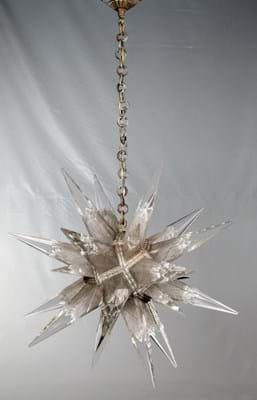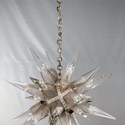Two very different forms of lighting – a classic piece of post-war Italian minimalism and a more elaborate inter-war Czech glass chandelier – were among the best-sellers in two German auctions in February.
Selected for the catalogue cover of Quittenbaum’s (23% buyer’s premium) 240-lot sale of Italian design in Munich on February 21 was a floor lamp designed in 1954 by Gino Sarfatti (1912-85) and manufactured by Arteluce.
Sarfatti had originally hoped to become an aerospace engineer, but was forced to abandon his studies as he lacked sufficient funds and after working as a glass salesman he set up his own lighting business, Arteluce, in Milan in 1939.
Entirely self-taught, he created some 700 different models, all with the aim of producing what he termed “rational lighting”. His designs were often way ahead of their time and have not only retained their popularity but are now sought as design classics.
Quittenbaum’s lamp, number 1063, was characteristically minimalist: a slender, 7ft 1in (2.16m) tall metal tube kept upright by two small metal rods, fixed to a metal box which houses the power supply.
Five bidders on the phone and several more bidding online joined in the fray, nudging the price from €14,000 to a final €24,000 (£20,870). It was secured by a Parisian dealer who also carried off one of Sarfatti’s ceiling lights, model number 2042/9 from 1963, for €3500 (£3045).
Czech in
Two days later on February 23 in Plauen, a German town on the borders of the Czech Republic, Mehlis (20% buyer’s premium) was offering two unusual stellar form glass chandeliers from the 1930s.
They were manufactured in the Czech town of Carlsbad (Karlovy Var) by the famous Moser glassworks, a company founded by Ludwig Moser in 1893 that is still producing today.
Star-shaped chandeliers were popular in the Art Deco era but the form of the chandeliers offered in Plauen is based on the so-called Moravian star, the facets etched with ice-crystal patterns in high relief.
This type of multi-pointed star was first created by members of the Moravian Church in the early 19th century.
Stars of this type can have anything from 20 to a maximum of 110 points. It has since become a popular Advent and Christmas symbol in many parts of the world, not only among church members.
On sale day vigorous bidding from several quarters greeted this duo, which continued to €40,000 (£34,780), paid by a German collector.
£1 = €1.15


















